
Principles of General, Organic, Biological Chemistry
2nd Edition
ISBN: 9780073511191
Author: Janice Gorzynski Smith Dr.
Publisher: McGraw-Hill Education
expand_more
expand_more
format_list_bulleted
Question
Chapter 2, Problem 2.56AP
(a)
Interpretation Introduction
Interpretation:
The marked element (a) in the given figure have to be given.
The given diagram is,
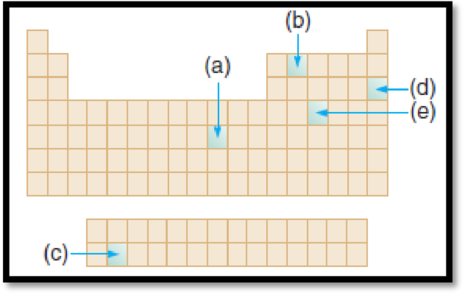
Figure 1
(b)
Interpretation Introduction
Interpretation:
The marked element (b) in the given figure has to be given.
The given diagram is,
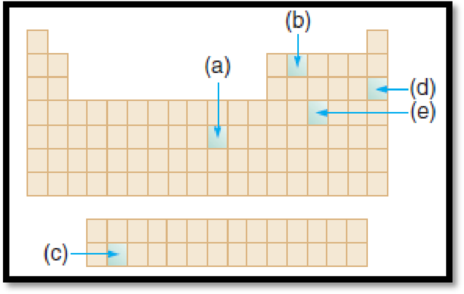
Figure 1
(c)
Interpretation Introduction
Interpretation:
The marked element (c) in the given figure has to be given.
The given diagram is,
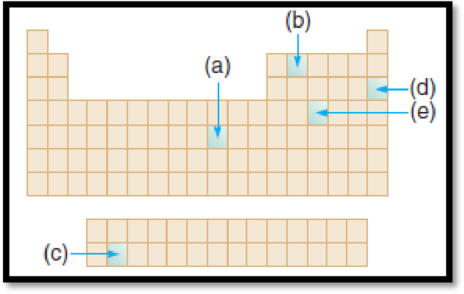
Figure 1
(d)
Interpretation Introduction
Interpretation:
The marked element (d) in the given figure has to be given.
The given diagram is,
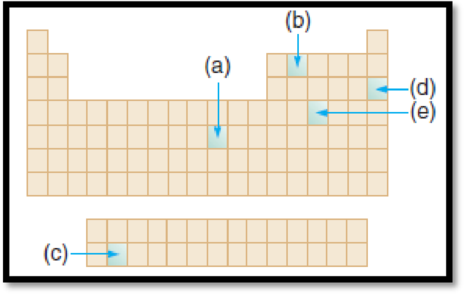
Figure 1
(e)
Interpretation Introduction
Interpretation:
The marked element (e) in the given figure has to be given.
The given diagram is,
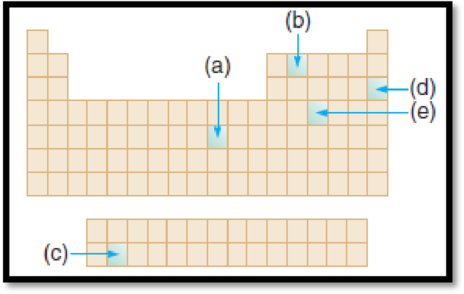
Figure 1
Expert Solution & Answer
Want to see the full answer?
Check out a sample textbook solution
Students have asked these similar questions
Is nucleophilic acyl substitution an SN1 or SN2 reaction?
Draw product A, indicating what type of reaction occurs.
NH2
F3C
CF3
NH
OMe
NH2-NH2, ACOH
A
Photochemical smog is formed in part by the action of light on nitrogen dioxide. The wavelength of radiation absorbed by NO2 in this reaction is 197 nm.(a) Draw the Lewis structure of NO2 and sketch its π molecular orbitals.(b) When 1.56 mJ of energy is absorbed by 3.0 L of air at 20 °C and 0.91 atm, all the NO2 molecules in this sample dissociate by the reaction shown. Assume that each absorbed photon leads to the dissociation (into NO and O) of one NO2 molecule. What is the proportion, in parts per million, of NO2 molecules in this sample? Assume that the sample behaves ideally.
Chapter 2 Solutions
Principles of General, Organic, Biological Chemistry
Ch. 2.1 - Give the symbol for each element. a. calcium, a...Ch. 2.1 - Prob. 2.2PCh. 2.1 - Give the name corresponding to each element...Ch. 2.1 - Locate each element in the periodic table and...Ch. 2.1 - Classify each micronutrient in Figure 2.2 as a...Ch. 2.1 - Identify the elements used in each example of...Ch. 2.1 - Identify the elements in each chemical formula,...Ch. 2.1 - Prob. 2.8PCh. 2.2 - Prob. 2.9PCh. 2.2 - Prob. 2.10P
Ch. 2.2 - Prob. 2.11PCh. 2.2 - Prob. 2.12PCh. 2.2 - Prob. 2.13PCh. 2.3 - Prob. 2.14PCh. 2.3 - Prob. 2.15PCh. 2.3 - Prob. 2.16PCh. 2.3 - Prob. 2.17PCh. 2.3 - Prob. 2.18PCh. 2.4 - Prob. 2.19PCh. 2.4 - Give the period and group number for each element:...Ch. 2.4 - Prob. 2.21PCh. 2.4 - Prob. 2.22PCh. 2.5 - Prob. 2.23PCh. 2.6 - Prob. 2.24PCh. 2.6 - Prob. 2.25PCh. 2.6 - Prob. 2.26PCh. 2.7 - Identify the total number of electrons, the number...Ch. 2.7 - Prob. 2.28PCh. 2.7 - Prob. 2.29PCh. 2.8 - Which element in each pair has the larger atomic...Ch. 2.8 - Which element in each pair has the higher...Ch. 2.8 - Prob. 2.32PCh. 2 - Identify the elements used in each example of...Ch. 2 - Prob. 2.34UKCCh. 2 - Prob. 2.35UKCCh. 2 - Prob. 2.36UKCCh. 2 - Prob. 2.37UKCCh. 2 - Prob. 2.38UKCCh. 2 - Prob. 2.39UKCCh. 2 - Prob. 2.40UKCCh. 2 - Prob. 2.41UKCCh. 2 - Prob. 2.42UKCCh. 2 - Prob. 2.43UKCCh. 2 - Prob. 2.44UKCCh. 2 - Prob. 2.45APCh. 2 - Prob. 2.46APCh. 2 - Prob. 2.47APCh. 2 - Identify the elements in each chemical formula and...Ch. 2 - Prob. 2.49APCh. 2 - Prob. 2.50APCh. 2 - Prob. 2.51APCh. 2 - Prob. 2.52APCh. 2 - Prob. 2.53APCh. 2 - Prob. 2.54APCh. 2 - Prob. 2.55APCh. 2 - Prob. 2.56APCh. 2 - Prob. 2.57APCh. 2 - Prob. 2.58APCh. 2 - The most common isotope of oxygen has a mass...Ch. 2 - Prob. 2.60APCh. 2 - Prob. 2.61APCh. 2 - Prob. 2.62APCh. 2 - Prob. 2.63APCh. 2 - Prob. 2.64APCh. 2 - Prob. 2.65APCh. 2 - Prob. 2.66APCh. 2 - Prob. 2.67APCh. 2 - Prob. 2.68APCh. 2 - Prob. 2.69APCh. 2 - Prob. 2.70APCh. 2 - Prob. 2.71APCh. 2 - Prob. 2.72APCh. 2 - Prob. 2.73APCh. 2 - Prob. 2.74APCh. 2 - Prob. 2.75APCh. 2 - Prob. 2.76APCh. 2 - Prob. 2.77APCh. 2 - Prob. 2.78APCh. 2 - Prob. 2.79APCh. 2 - Prob. 2.80APCh. 2 - Prob. 2.81APCh. 2 - Prob. 2.82APCh. 2 - Prob. 2.83APCh. 2 - Arrange the elements in each group in order of...Ch. 2 - Prob. 2.85APCh. 2 - Prob. 2.86APCh. 2 - Answer the following questions about...Ch. 2 - Prob. 2.88APCh. 2 - Prob. 2.89APCh. 2 - (a) What is the chemical formula for...Ch. 2 - Prob. 2.91CPCh. 2 - Prob. 2.93BTCCh. 2 - Prob. 2.95BTC
Knowledge Booster
Learn more about
Need a deep-dive on the concept behind this application? Look no further. Learn more about this topic, chemistry and related others by exploring similar questions and additional content below.Similar questions
- Correct each molecule in the drawing area below so that it has the skeletal ("line") structure it would have if it were dissolved in a 0.1 M aqueous solution of HCI. If there are no changes to be made, check the No changes box under the drawing area. No changes. HO Explanation Check NH, 2 W O :□ G ©2025 M unter Accessibilityarrow_forwardAn expression for the root mean square velocity, vrms, of a gas was derived. Using Maxwell’s velocity distribution, one can also calculate the mean velocity and the most probable velocity (mp) of a collection of molecules. The equations used for these two quantities are vmean=(8RT/πM)1/2 and vmp=(2RT/M)1/2 These values have a fixed relationship to each other.(a) Arrange these three quantities in order of increasing magnitude.(b) Show that the relative magnitudes are independent of the molar mass of the gas.(c) Use the smallest velocity as a reference for establishing the order of magnitude and determine the relationship between the larger and smaller values.arrow_forwardThe reaction of solid dimethylhydrazine, (CH3)2N2H2, and liquefied dinitrogen tetroxide, N2O4, has been investigated for use as rocket fuel. The reaction produces the gases carbon dioxide (CO2), nitrogen (N2), and water vapor (H2O), which are ejected in the exhaust gases. In a controlled experiment, solid dimethylhydrazine was reacted with excess dinitrogen tetroxide, and the gases were collected in a closed balloon until a pressure of 2.50 atm and a temperature of 400.0 K were reached.(a) What are the partial pressures of CO2, N2, and H2O?(b) When the CO2 is removed by chemical reaction, what are the partial pressures of the remaining gases?arrow_forward
- One liter of chlorine gas at 1 atm and 298 K reacts completely with 1.00 L of nitrogen gas and 2.00 L of oxygen gas at the same temperature and pressure. A single gaseous product is formed, which fills a 2.00 L flask at 1.00 atm and 298 K. Use this information to determine the following characteristics of the product:(a) its empirical formula;(b) its molecular formula;(c) the most favorable Lewis formula based on formal charge arguments (the central atom is N);(d) the shape of the molecule.arrow_forwardHow does the square root mean square velocity of gas molecules vary with temperature? Illustrate this relationship by plotting the square root mean square velocity of N2 molecules as a function of temperature from T=100 K to T=300 K.arrow_forwardDraw product B, indicating what type of reaction occurs. F3C CF3 NH2 Me O .N. + B OMearrow_forward
- Benzimidazole E. State its formula. sState the differences in the formula with other benzimidazoles.arrow_forwardDraw product A, indicating what type of reaction occurs. F3C CN CF3 K2CO3, DMSO, H₂O2 Aarrow_forward19) Which metal is most commonly used in galvanization to protect steel structures from oxidation? Lead a. b. Tin C. Nickel d. Zinc 20) The following molecule is an example of a: R₁ R2- -N-R3 a. Secondary amine b. Secondary amide c. Tertiary amine d. Tertiary amidearrow_forward
arrow_back_ios
SEE MORE QUESTIONS
arrow_forward_ios
Recommended textbooks for you
 Chemistry: Principles and PracticeChemistryISBN:9780534420123Author:Daniel L. Reger, Scott R. Goode, David W. Ball, Edward MercerPublisher:Cengage Learning
Chemistry: Principles and PracticeChemistryISBN:9780534420123Author:Daniel L. Reger, Scott R. Goode, David W. Ball, Edward MercerPublisher:Cengage Learning Chemistry for Today: General, Organic, and Bioche...ChemistryISBN:9781305960060Author:Spencer L. Seager, Michael R. Slabaugh, Maren S. HansenPublisher:Cengage Learning
Chemistry for Today: General, Organic, and Bioche...ChemistryISBN:9781305960060Author:Spencer L. Seager, Michael R. Slabaugh, Maren S. HansenPublisher:Cengage Learning Chemistry for Engineering StudentsChemistryISBN:9781337398909Author:Lawrence S. Brown, Tom HolmePublisher:Cengage Learning
Chemistry for Engineering StudentsChemistryISBN:9781337398909Author:Lawrence S. Brown, Tom HolmePublisher:Cengage Learning Introductory Chemistry: An Active Learning Approa...ChemistryISBN:9781305079250Author:Mark S. Cracolice, Ed PetersPublisher:Cengage Learning
Introductory Chemistry: An Active Learning Approa...ChemistryISBN:9781305079250Author:Mark S. Cracolice, Ed PetersPublisher:Cengage Learning Chemistry for Engineering StudentsChemistryISBN:9781285199023Author:Lawrence S. Brown, Tom HolmePublisher:Cengage Learning
Chemistry for Engineering StudentsChemistryISBN:9781285199023Author:Lawrence S. Brown, Tom HolmePublisher:Cengage Learning

Chemistry: Principles and Practice
Chemistry
ISBN:9780534420123
Author:Daniel L. Reger, Scott R. Goode, David W. Ball, Edward Mercer
Publisher:Cengage Learning

Chemistry for Today: General, Organic, and Bioche...
Chemistry
ISBN:9781305960060
Author:Spencer L. Seager, Michael R. Slabaugh, Maren S. Hansen
Publisher:Cengage Learning

Chemistry for Engineering Students
Chemistry
ISBN:9781337398909
Author:Lawrence S. Brown, Tom Holme
Publisher:Cengage Learning

Introductory Chemistry: An Active Learning Approa...
Chemistry
ISBN:9781305079250
Author:Mark S. Cracolice, Ed Peters
Publisher:Cengage Learning


Chemistry for Engineering Students
Chemistry
ISBN:9781285199023
Author:Lawrence S. Brown, Tom Holme
Publisher:Cengage Learning
Periodic Properties of Elements | Chemistry | IIT-JEE | NEET | CBSE | Misostudy; Author: Misostudy;https://www.youtube.com/watch?v=L26rRWz4_AI;License: Standard YouTube License, CC-BY
Periodic Trends: Electronegativity, Ionization Energy, Atomic Radius - TUTOR HOTLINE; Author: Melissa Maribel;https://www.youtube.com/watch?v=0h8q1GIQ-H4;License: Standard YouTube License, CC-BY